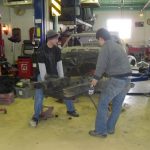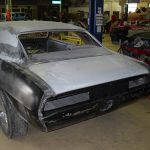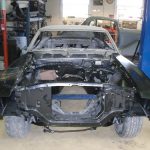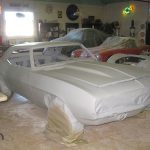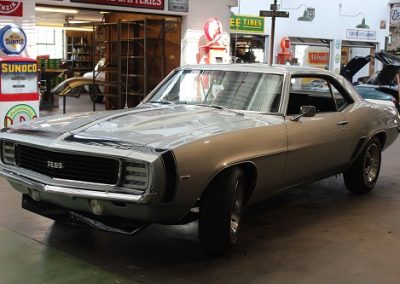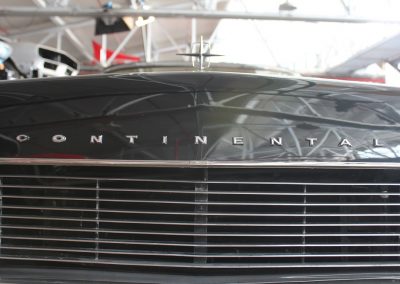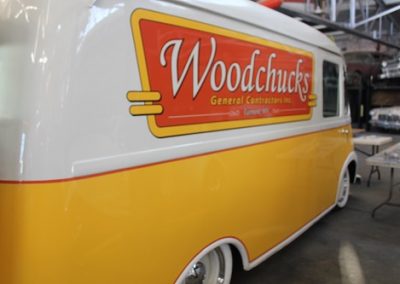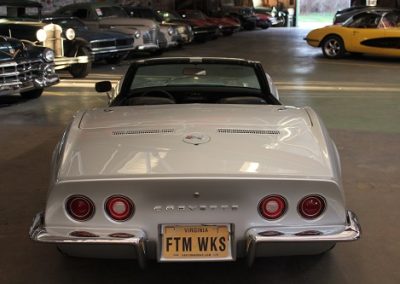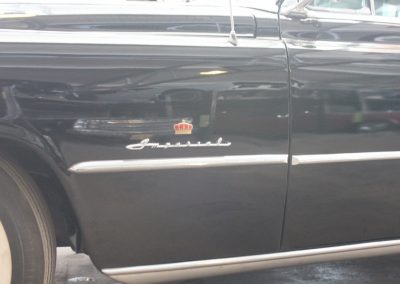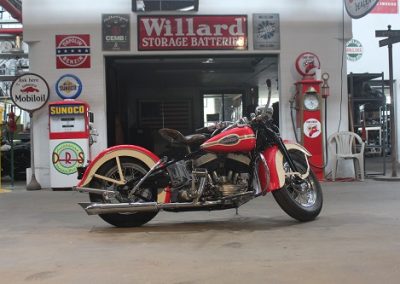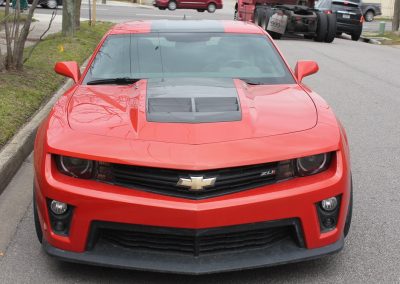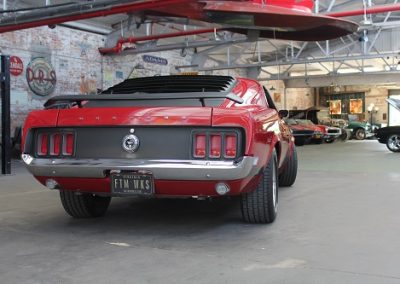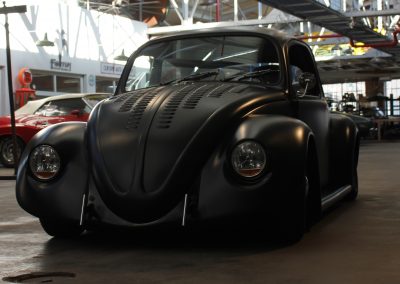1969 Chevrolet Camaro ZL1

As seen on Season Eight of FantomWorks
Owner Insight:
Explore the Project Galleries
Disassembly
Strip & Metal Fab
Mechanical
Body & Paint
Finish
The first-generation Chevrolet Camaro appeared in Chevrolet dealerships in September 29, 1966 for the 1967 model year on a brand-new rear wheel drive GM F-body platform and was available as a 2-door, 2+2 seat, hardtop (no “B” or center pillar) or convertible, with the choice of either a straight-6 or V8 engine. The first-generation Camaro was built through the 1969 model year.
Almost all of 1967-1969 Camaros were built in the two U.S. assembly plants: Norwood, Ohio and Van Nuys, California. There were also five non-U.S. Camaro assembly plants in countries that required local assembly and content. These plants were located in the Philippines, Belgium, Switzerland, Venezuela, and Peru.
The 1969 Camaro carried over the previous year’s drivetrain and major mechanical components, but all-new sheet metal, except the hood and trunk lid, gave the car a substantially sportier look. The grille was redesigned with a heavy “V” cant and deeply inset headlights. New door skins, rear quarter panels, and rear valance panel also gave the car a much lower, wider, more aggressive look. This styling would serve for the 1969 model year only. Collectors often debate the merits of smooth, rounded lines of 1967 and 1968 model versus the heavily creased and sportier looks of the 1969.
To increase competitiveness in the SCCA Trans-Am racing series, optional four wheel disc brakes with four-piston calipers were made available during the year, under RPO JL8, for US$500.30. This system used components from the Corvette and made for a major improvement in the braking capability and was a key to winning the Trans-Am championship. The option was expensive and only 206 units were produced.
The Rally Sport (RS) option, RPO Z22, includes special black painted grille with concealed headlights and headlight washers, fender striping (except when sport striping or Z28 Special Performance Package is specified), simulated rear fender louvers, front and rear wheel opening moldings, black body sill, RS emblems on grille, steering wheel and rear panel, Rally Sport front fender nameplates, bright accented taillights, back-up lights below rear bumper; also includes bright roof drip moldings on Sport Coupe. $131.65, 37,773 built. This option could be added to any other option (i.e., SS or Z/28), making the model an RS/SS or a RS/Z28.
The Z28 option was still available with the 302 cu in (4.9 L) small block producing 290 hp (294 PS; 216 kW) at 5800 rpm and 290 lb·ft (393 N·m) of torque at 4200 rpm. It was backed by Muncie four-speed with a new-for-69 standard Hurst shifter and connected to a 12-bolt rear axle with standard 3.73 gears. The 302 featured 11:1 compression, forged pistons, forged steel crankshaft and connecting rods, solid lifter camshaft, and Holley carburetion on a dual-plane intake manifold. A dual four-barrel crossram intake manifold was available as a dealer-installed option.
The 1969 model year was exceptionally long, extending into November 1969, due to manufacturing problem that delayed the introduction of the second generation model planned for 1970. It is a popular myth late-’69 Camaros were sold as 1970 models (due to GM publicity pictures of the ’69 Camaro labeled as a 1970), but they were all assigned 1969 VIN codes.
A GM corporate edict forbade Chevrolet from installing engines larger than 400 cu in (6.6 l). Requests from dealers (notably Don Yenko) who were dealer-installing 427 cu in (7.0 L) engines in the Camaro caused Chevrolet to use an ordering process usually used on fleet and special orders (taxis, trucks, etc.) to offer 427 engines in the Camaro. Two Central Office Production Orders (COPO), numbers 9560 and 9561, were offered in the 1969 model year.
The COPO 9561 used the solid-lifter L72 big-block engine, making an underrated 425 hp (317 kW) SAE gross at 5600 rpm and 460 lb·ft (624 N·m) of torque at 4000 rpm. Yenko ordered 201 of these cars to create the now-legendary Yenko Camaro. Other dealers also became aware of the L72 engine package and ordered it. Around 900-1,000 Camaros were fitted with the L72 engine option.
The COPO 9560 used an all-aluminum 427 cu in (7.0 L) big-block called the ZL-1 and was designed specifically for drag racing. The package was conceived by drag racer Dick Harrell, and ordered through Fred Gibb Chevrolet in La Harpe, IL, with the intention of entering NHRA Super Stock (drag racing). A total of 69 ZL-1 Camaros were produced. The engine alone cost over US$4,000—more than the cost of a base V8 hardtop. Though rated at 430 hp (321 kW) gross at 5200 rpm and 450 lb·ft (610 N·m) of torque at 4400 rpm, the ZL-1 made 376 hp (280 kW) SAE net in its “as installed” state. With exhaust changes and some tuning, the horsepower jumped to over 500.
The ZL1 engines were hand assembled in a process that took 16 hours each, in a room that Corvette Chief Engineer Zora Arkus-Duntov described as “surgically clean.” All ZL1 engines were manufactured at the Tonawanda Assembly Plant before being installed in Corvettes and Camaros, or sold over the counter to racers.
Two of the 69 ZL-1’s are known to have landed in Australia, with both owned by local motor racing legend and multi-millionaire tyre retailer Bob Jane, with both cars painted in Jane’s team colour Sebring Orange. One of the Camaros was used by Jane for drag racing in Australia (Jane also owned the Calder Park Raceway with the main straight doubling as one of the country’s premier drag racing strips). Jane drove the other Camaro to win the 1971 and 1972 Australian Touring Car Championships (the forerunner to today’s V8 Supercars), though due to regulation changes restricting engines to a maximum cubic capacity of 6000 cc, Jane was forced to replace the 427 engine with a 350 in 1972. The ATCC winner, which holds the record for the largest capacity car to ever win the championship since it began in 1960. As of 2016, Jane owns his ATCC winning ZL-1, which after its touring car life was sold and used as a Sports Sedan and a drag racer before Jane bought it back and had the car restored to its 1971 specification. Despite his advancing years (approximately 86-87), Jane and the car continue to regularly appear at major historic meetings including the annual Australian Muscle Car Masters held each Fathers Day at the Sydney Motorsport Park.
https://en.wikipedia.org/wiki/Chevrolet_Camaro_(first_generation)
